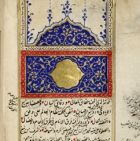The Mozarabic rite, a distinct form of Catholic worship, is approved by Pope John X. Arabized Christians in Al-Andalus offered liturgies and prayers in Arabic and Romance languages rather than Latin.
New Poetic Forms Emerge In Andalus
New poetic forms emerge in Andalus. Ibn Mu’afa of Cabra composes an early type of muwashshaha, a short poem with variable rhymes. Another form, the zajal, is composed in Romance but uses Arabic meter, reflecting a fluid melding of cultures. Around this time, Ibn Abd Rabbihi pens the Iqd al-Farid…
Umar ibn Hafsun Begins a Revolt
The muwallad, Umar ibn Hafsun, begins a revolt against the Umayyads. From his refuge in the castle of Bobastro, he steadily attracts the support of disaffected muwallads and Mozarabs, and takes control of numerous towns and castles. The Umayyad rulers begin employing mercenary soldiers, including Christian Castilians, Muslim Berbers and…
Ambassadors Bring Gifts To Adorn the Great Mosque
Ambassadors from the Byzantine Empire bring beautiful mosaics as gifts to adorn the Great Mosque of Córdoba. Increasing numbers of Hispani-Romans, called Mozarabs, adopt Arabic language, customs, and tastes, while retaining their Christian faith.
Abd al-Rahman II Becomes Amir
Abd al-Rahman II becomes amir. The strong leader repulses an assault by Vikings in 844; establishes a fleet and naval arsenal at Seville; and expands the countryside’s agricultural capacity. He invites the Iraqi musician Ziryab to his court, and patronizes the arts and sciences. Al-Andalus begins earning a reputation for…
Amir Abd al-Rahman Purchases the Church of St. Vincent
The amir Abd al-Rahman purchases the Church of St. Vincent — part of which had been shared by Muslims since the conquest — from the local Christian community. On the site of an earlier Roman temple, he now begins building the Great Mosque of Córdoba. Harun al-Rashid begins ruling as…










